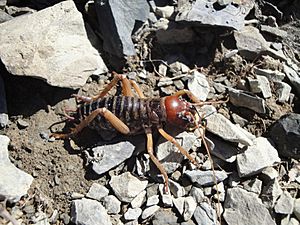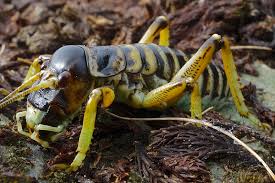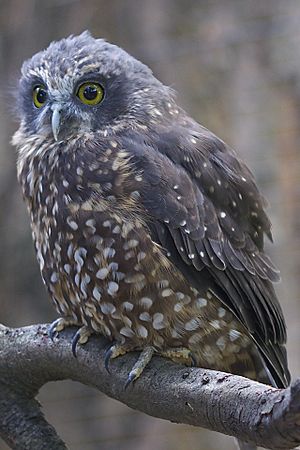Mountain stone weta facts for kids
Quick facts for kids Mountain stone weta |
|
|---|---|
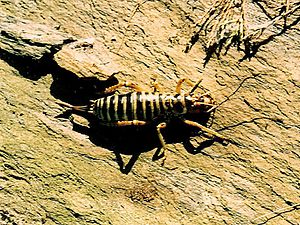 |
|
| Female | |
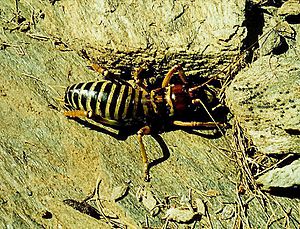 |
|
| Male | |
| Scientific classification | |
| Kingdom: | |
| Phylum: | |
| Class: | |
| Order: | |
| Suborder: | |
| Family: |
Anostostomatidae
|
| Genus: |
Hemideina
|
| Species: |
H. maori
|
| Binomial name | |
| Hemideina maori |
|
The Hemideina maori, also known as the mountain stone wētā, is a special type of wētā. These large, flightless insects are found only in New Zealand. They are active at night and live for many years. You can find mountain stone wētā on the high mountain ranges of New Zealand's South Island.
Contents
About the Mountain Stone Wētā
The mountain stone wētā, Hemideina maori, was first described in 1891. Two scientists from Switzerland, Alphonse Pictet and Henri de Saussure, gave it its scientific name.
Where They Live
Unlike other wētā species, the mountain stone wētā lives in cold, high-up places. They are found above the tree line in the South Island of New Zealand. This means they live in areas where trees cannot grow because it's too cold or windy.
They have been found at heights over 1,500 meters (about 4,900 feet) above sea level. The lowest they are usually found is around 1,100 meters (about 3,600 feet). Their home stretches from the Kaikōura Ranges down to the Rock and Pillar Range in Otago.
During the day, they hide in small spaces under large rocks called 'tors'. These rocks have broken off from bigger rock formations. The areas between these rocky spots are often grassy meadows without rocks. This means the wētā populations can be separated into different groups.
Mountain wētā do not move far from their homes during their lives. They face strong winds and cold temperatures all year round.
What They Eat
Scientists have studied the droppings of mountain stone wētā to learn what they eat. Their diet includes many different kinds of plants. They also eat a few types of small invertebrates. The plants they prefer often have a higher amount of lipids (fats).
There are not many studies about what H. maori eats. However, we know they are omnivores. This means they eat both plants and other living or decaying matter.
How They Look
H. maori are large wētā, growing to about 6 centimeters (2.4 inches) long. The length of their lower leg (tibia) is about the same for both males and females.
Both male and female wētā have mandibles (jaws) that are not perfectly even. The left mandible is usually a bit longer than the right one.
Male wētā can look very different from each other. Some males have much longer mandibles and wider heads. These differences seem to be because males fight each other to win over females. The males with bigger jaws often have an advantage in these fights.
Body Colour
Mountain stone wētā can be either black or yellow. Scientists have studied areas where both colors are found, like the Rock and Pillar mountain range. They found that both black and yellow wētā in this area came from the same original group. This suggests that the wētā had these different colors even before they spread out into separate groups.
How They Survive the Cold
Adapting to Mountain Life
Mountain wētā are very good at holding onto water in their bodies. They lose less water through their skin and when they breathe compared to wētā that live in warmer, lower areas. This helps them survive in the dry, windy mountain environment. Scientists also found that the black wētā lose less water overall than the yellow wētā.
Surviving Freezing Temperatures
One of the most amazing things about mountain stone wētā is that they can survive being completely frozen solid! They are thought to be inactive for at least five months of the year during winter.
In winter, you might find H. maori completely still, with ice crystals on their bodies. If you touch them, they feel frozen solid. But on warmer days, they can thaw out and become active again under their rocks.
When they are frozen, the wētā are in a state called suspended animation. This is like hitting the pause button on their life. They can survive up to 17 days in temperatures around -10 °C (14 °F). When it gets colder than -10 °C, about 85% of the water in their bodies turns into ice. This is one of the highest amounts of ice known for any animal!
To survive this, their blood (called haemolymph in insects) contains special substances. These are like natural antifreeze chemicals. They include amino acids, especially proline, and a sugar called trehalose. The wētā make these substances in the autumn. They help to reduce the amount of ice that forms in their bodies. They also protect the wētā's cells and proteins from damage when they freeze.
Behaviour
Unlike some other wētā, H. maori spends most of its time on the ground in its rock shelters. However, just like other wētā, they leave their hiding spots at night. They go out to find food and lay their eggs in the soil.
To protect themselves from animals that might try to eat them, mountain stone wētā often "play dead". They lie still on their backs for a short time, with their legs spread out and jaws wide open. They are ready to scratch and bite if needed. If a predator grabs them, they might also spit up a yucky liquid. This liquid can bother or even be a little bit toxic to the predator.
Predators
It seems that many common animal predators, like rats, possums, and cats, are not found in large numbers where the mountain stone wētā live. This is because the wētā live at very high elevations (above 1,100 meters).
This means that the main predators of the mountain stone wētā are likely native New Zealand animals. These include reptiles like geckos and skinks, or birds like the ruru (also known as the morepork).
Life Cycle and Reproduction
Mountain stone wētā have a long life cycle. It can take at least four years for them to become old enough to reproduce. Some wētā even live through at least four breeding seasons.
The mating season for H. maori usually finishes before the cold alpine winter begins. This is in autumn (March and April in the Southern Hemisphere). During this time, the days get cold, and the wētā become inactive in their rock shelters.
Male wētā often live with many females, sometimes up to seven females with one male. Males that live with more females have a better chance of mating. Adult males have larger heads and longer mandibles than adult females. This is called sexual dimorphism. H. maori have a mating system where one male mates with many females (harem-polygynous). Mating often happens inside their rock shelters. This allows the male to quickly mate with any female that returns to the shelter. Males use their large mandibles to fight other males for access to these groups of females.
Conservation Status
The mountain stone wētā is found across many ranges in the Southern Alps. Because of this, it is not currently considered to be at risk of extinction.
One study tracked 480 adult mountain stone wētā over three years. They found that 72% of the marked wētā were found again at least once. This shows that the populations are quite stable.


